NCERT Solutions for Class 12 Maths Chapter 13 - Probability - Exercise 13.4
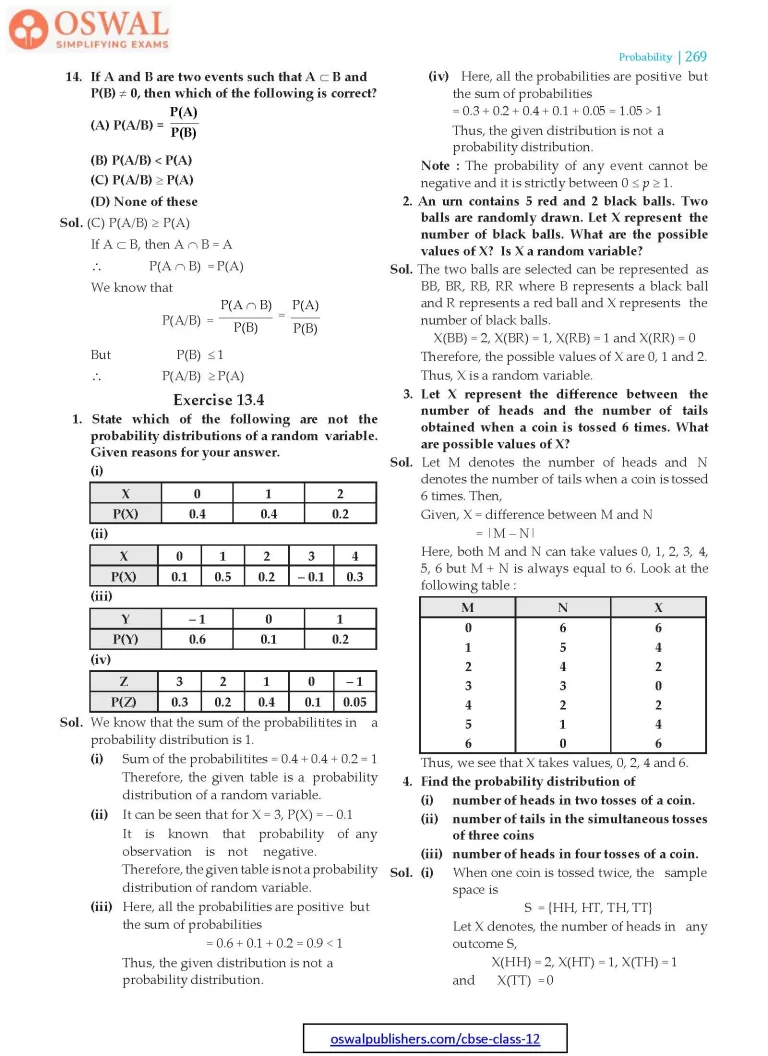
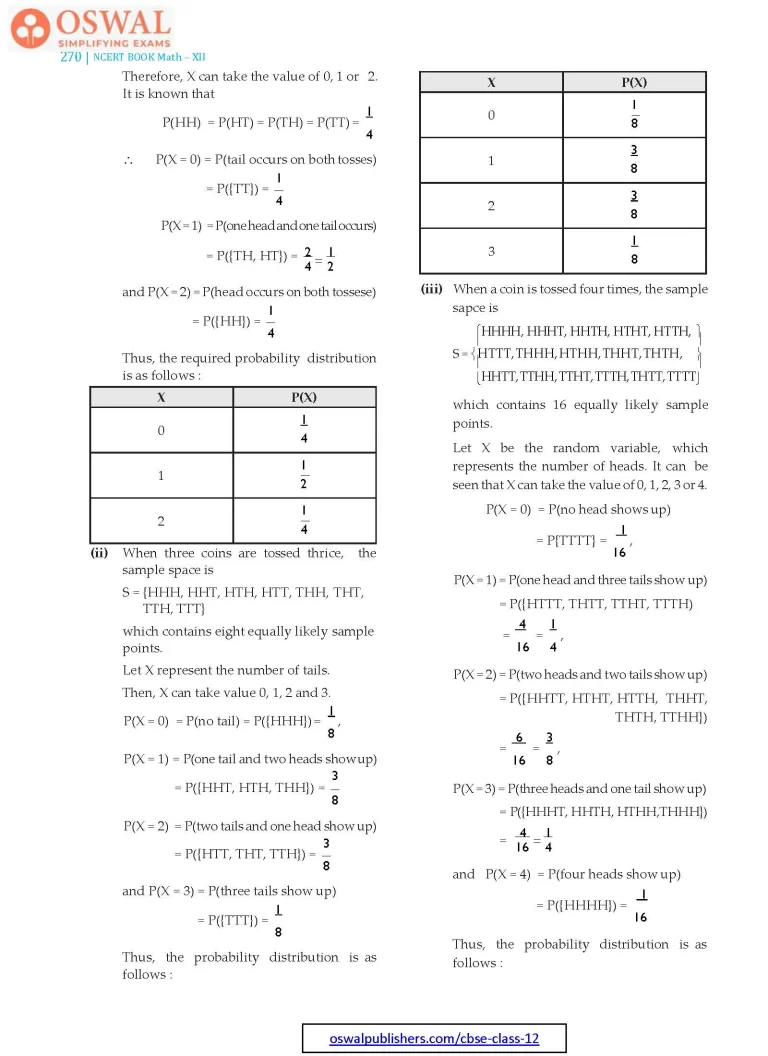
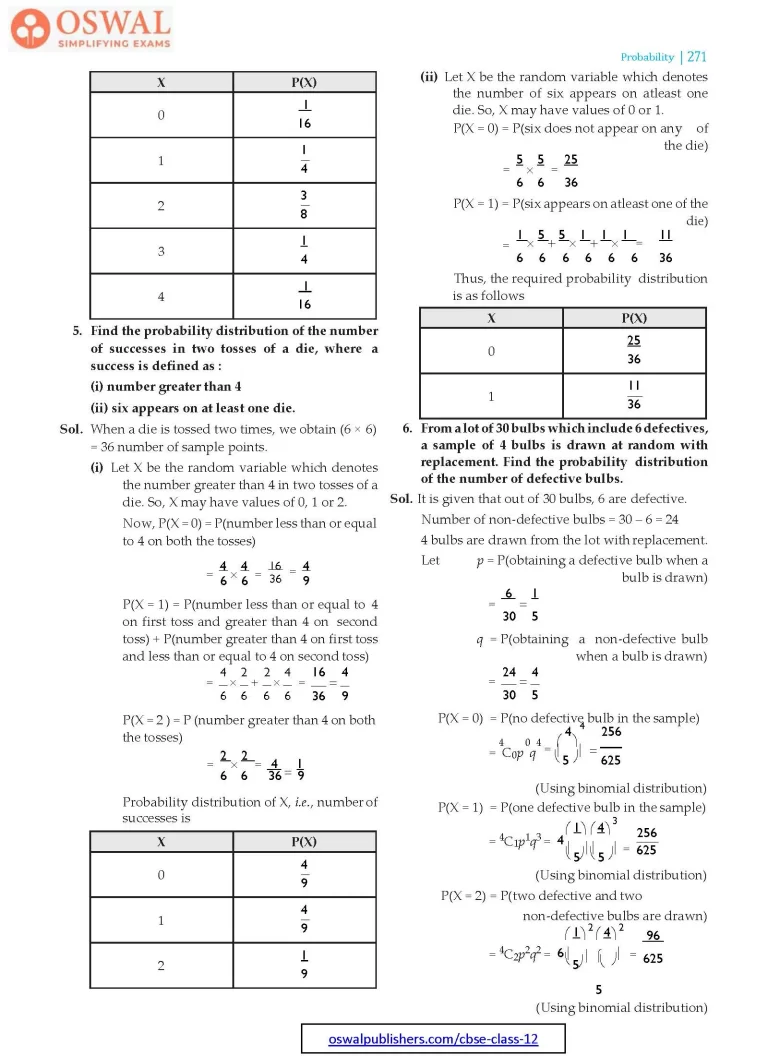
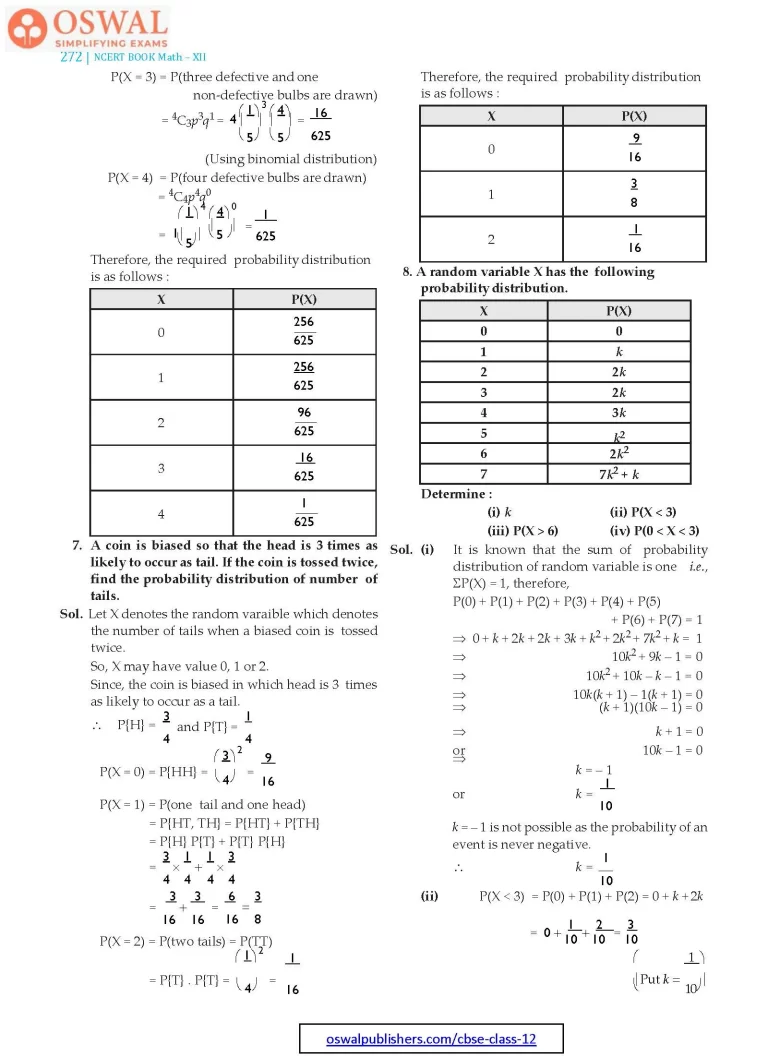
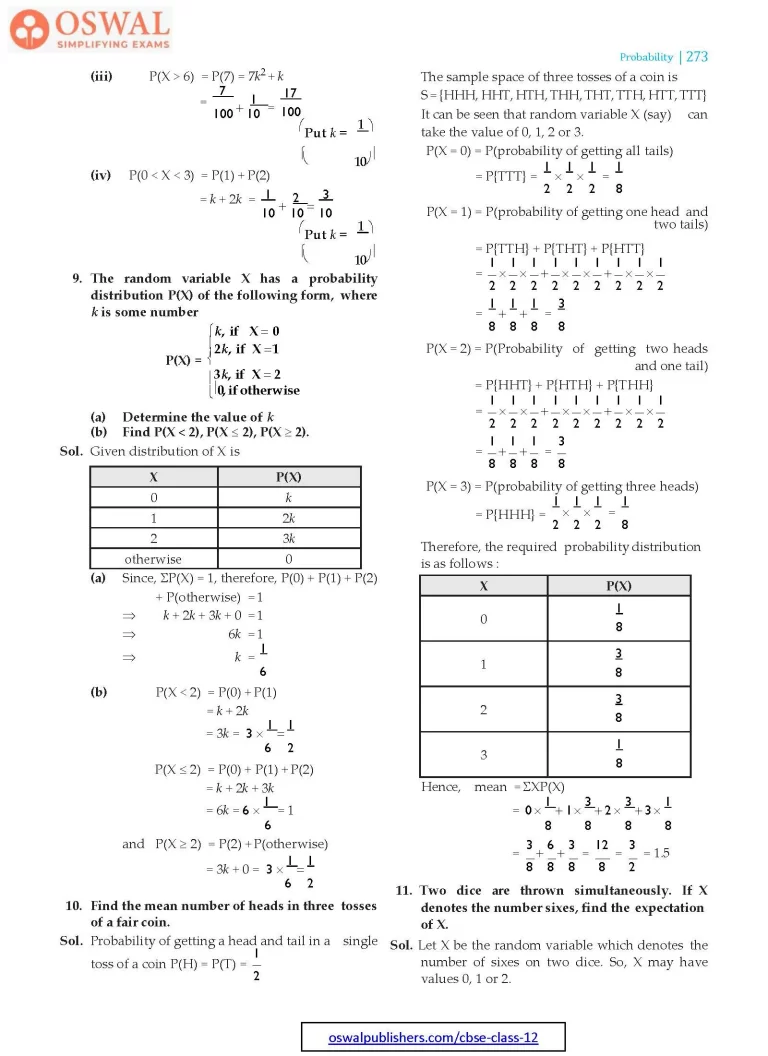
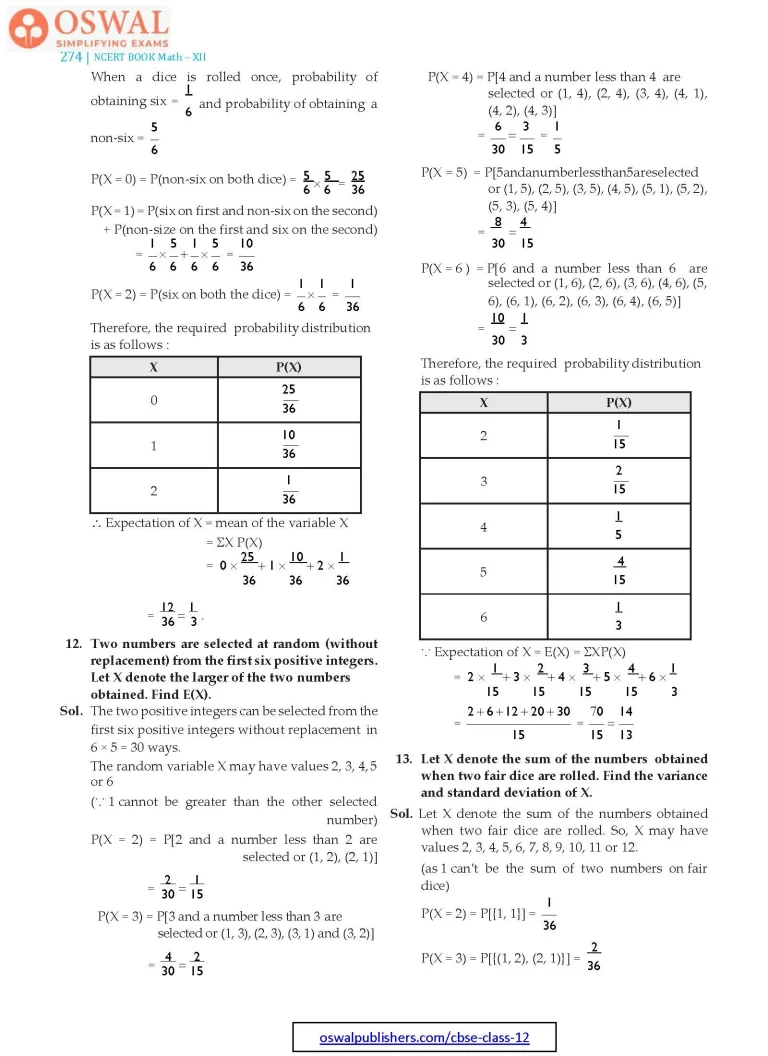
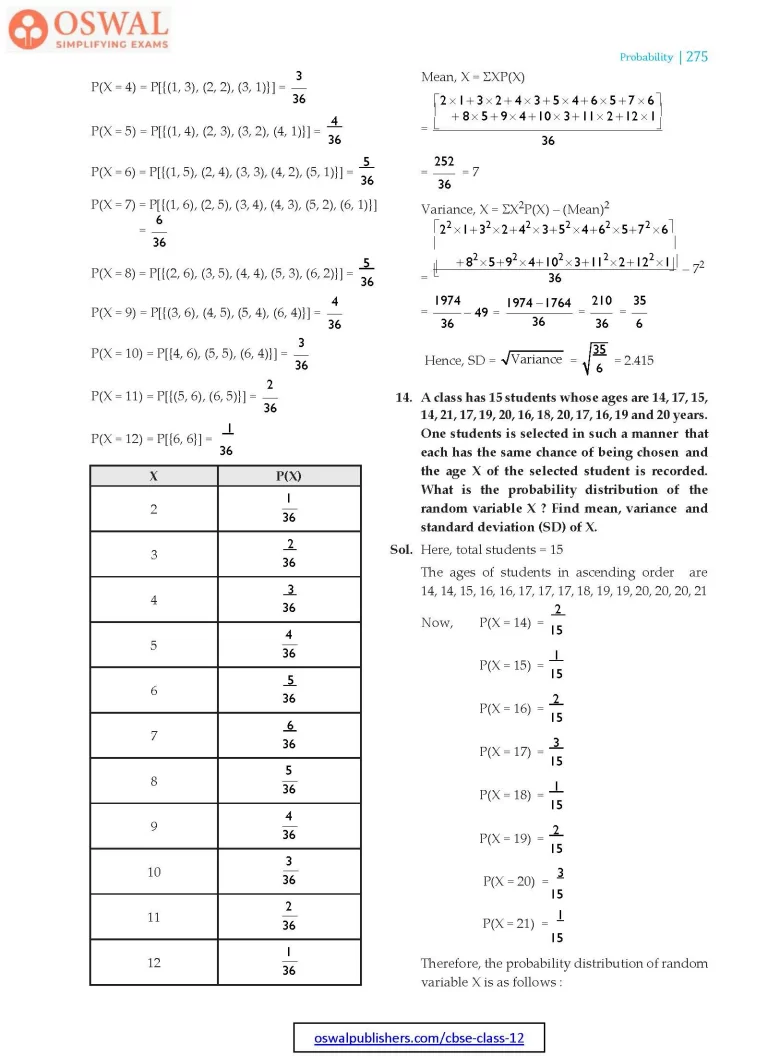
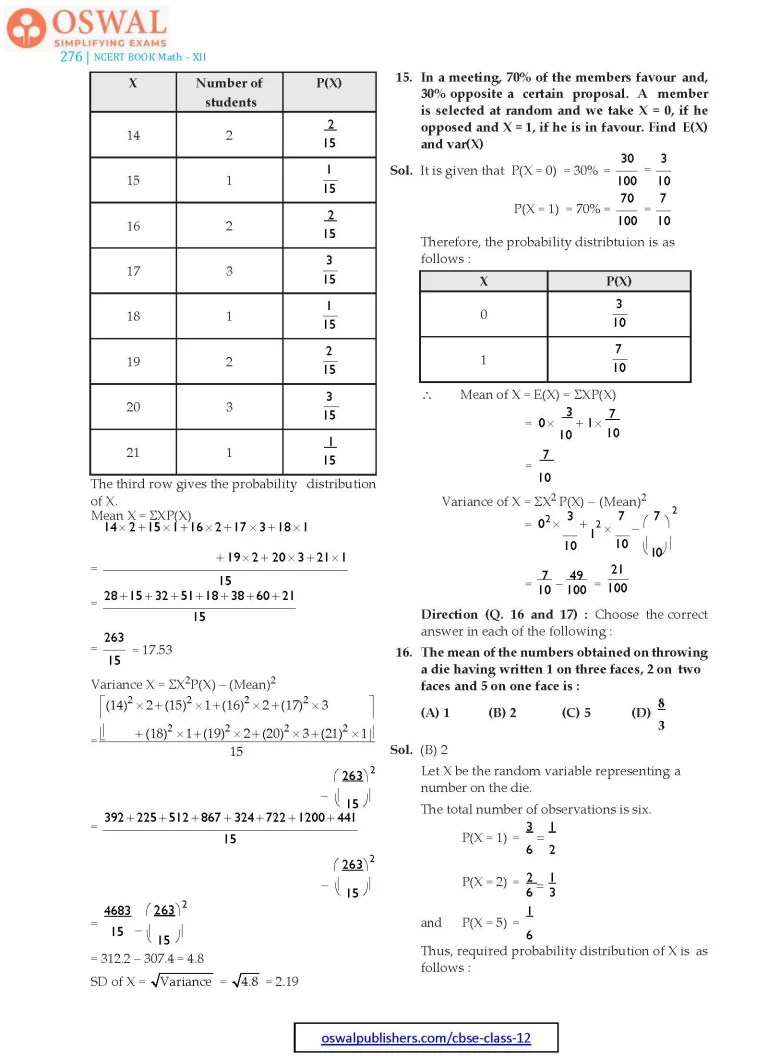
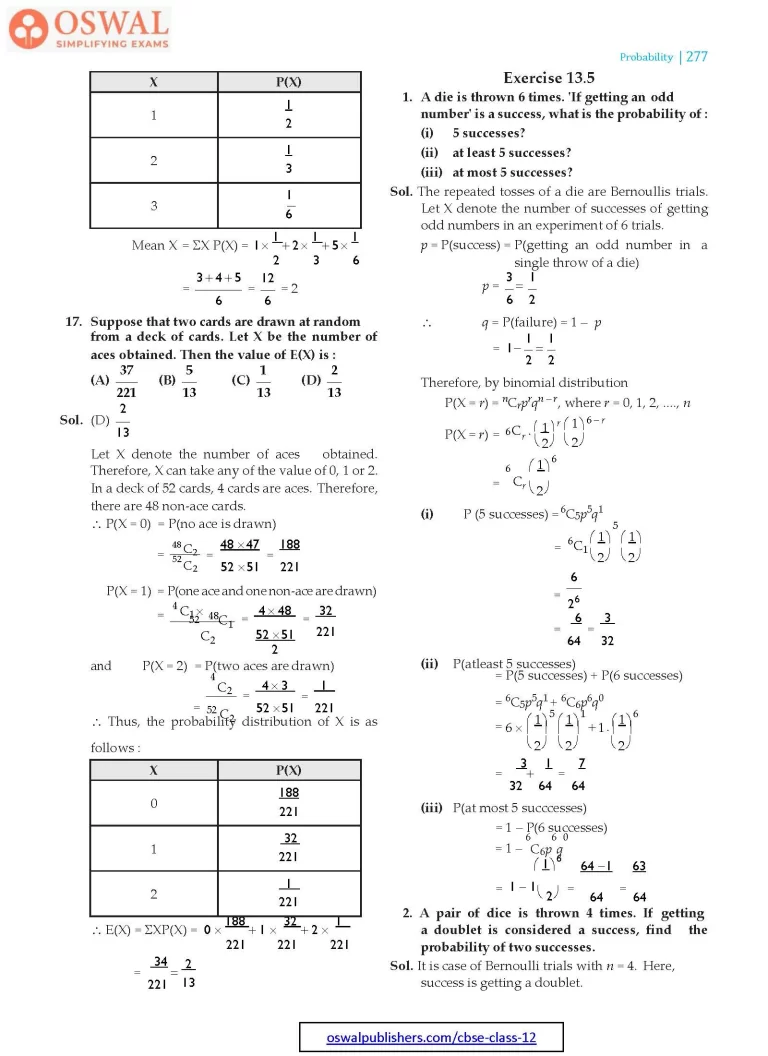
Access Exercises of Class 12 Maths Chapter 13 – Probability
Exercise 13.1 Solutions 17 Questions
Exercise 13.2 Solutions 18 Questions
Exercise 13.3 Solutions 14 Questions
Exercise 13.4 Solutions 17 Questions
Exercise 13.5 Solutions 15 Questions
Miscellaneous Exercise on Chapter 13 Solutions 10 Questions
Exercise 13.4
1. State which of the following are not the probability distributions of a random variable. Given reasons for your answer.
(i)
| X | 0 | 1 | 2 |
| P(X) | 0.4 | 0.4 | 0.2 |
(ii)
| X | 0 | 1 | 2 | 3 | 4 |
| P(X) | 0.1 | 0.5 | 0.2 | -0.1 | 0.3 |
(iii)
| Y | -1 | 0 | 1 |
| P(Y) | 0.6 | 0.1 | 0.2 |
(iv)
| Z | 3 | 2 | 1 | 0 | $$\normalsize-1$$ |
| P(Z) | 0.3 | 0.2 | 0.4 | 0.1 | 0.05 |
Sol. We know that the sum of the probabilitites in a probability distribution is 1.
(i) Sum of the probabilitites = 0.4 + 0.4 + 0.2 = 1
Therefore, the given table is a probability distribution of a random variable.
(ii) It can be seen that for X = 3, P(X) = – 0.1
It is known that probability of any observation is not negative.
Therefore, the given table is not a probability distribution of random variable.
(iii) Here, all the probabilities are positive but the sum of probabilities
= 0.6 + 0.1 + 0.2 = 0.9 < 1
Thus, the given distribution is not a probability distribution.
(iv) Here, all the probabilities are positive but the sum of probabilities
= 0.3 + 0.2 + 0.4 + 0.1 + 0.05 = 1.05 > 1
Thus, the given distribution is not a probability distribution.
Note : The probability of any event cannot be negative and it is strictly between 0 ≤ p ≥ 1.
2. An urn contains 5 red and 2 black balls. Two balls are randomly drawn. Let X represent the number of black balls. What are the possible values of X? Is X a random variable?
Sol. The two balls are selected can be represented as BB, BR, RB, RR where B represents a black ball and R represents a red ball and X represents the number of black balls.
X(BB) = 2, X(BR) = 1, X(RB) = 1 and X(RR) = 0
Therefore, the possible values of X are 0, 1 and 2.
Thus, X is a random variable.
3. Let X represent the difference between the number of heads and the number of tails obtained when a coin is tossed 6 times. What are possible values of X?
Sol. Let M denotes the number of heads and N denotes the number of tails when a coin is tossed 6 times. Then,
Given, X = difference between M and N
= |M – N|
Here, both M and N can take values 0, 1, 2, 3, 4, 5, 6 but M + N is always equal to 6. Look at the following table :
| M | N | X |
| 0 | 6 | 6 |
| 1 | 5 | 4 |
| 2 | 4 | 2 |
| 3 | 3 | 0 |
| 4 | 2 | 2 |
| 5 | 1 | 4 |
| 6 | 0 | 6 |
Thus, we see that X takes values, 0, 2, 4 and 6.
4. Find the probability distribution of
(i) number of heads in two tosses of a coin.
(ii) number of tails in the simultaneous tosses of three coins
(iii) number of heads in four tosses of a coin.
Sol. (i) When one coin is tossed twice, the sample space is
S = {HH, HT, TH, TT}
Let X denotes, the number of heads in any outcome S,
X(HH) = 2, X(HT) = 1, X(TH) = 1
and X(TT) = 0
Therefore, X can take the value of 0, 1 or 2. It is known that
$$\text{P(HH)} =\text{P(HT)} =\\\text{P(TH)} =\text{P(TT)} = \frac{1}{4}$$
∴ P(X = 0) = P(tail occurs on both tosses)
$$= \text{P}(\lbrace\text{TT}\rbrace) = \frac{1}{4}$$
P(X = 1) = P(one head and one tail occurs)
$$= \text{P(}\lbrace\text{TH, HT}\rbrace) =\frac{2}{4}= \frac{1}{2}$$
and P(X = 2) = P(head occurs on both tossese)
$$= \text{P (}\lbrace\text{HH}\rbrace) =\frac{1}{4}$$
Thus, the required probability distribution is as follows :
| X | P(X) |
| 0 | $$\frac{1}{4}$$ |
| 1 | $$\frac{1}{2}$$ |
| 2 | $$\frac{1}{4}$$ |
(ii) When three coins are tossed thrice, the sample space is
S = {HHH, HHT, HTH, HTT, THH, THT, TTH, TTT}
which contains eight equally likely sample points.
Let X represent the number of tails.
Then, X can take value 0, 1, 2 and 3.
P(X = 0) = P(no tail)
$$= \text{P}(\lbrace\text{HHH}\rbrace) = \frac{1}{8}.$$
P(X = 1) = P(one tail and two heads show up)
$$= \text{P}(\lbrace \text{HHT,HTH,THH}\rbrace) = \frac{3}{8}$$
P (X = 2) = P(two tails and one head show up)
$$ = \text{P(}\lbrace \text{HTT,THT, TTH}\rbrace) = \frac{3}{8}$$
and P(X = 3) = P(three tails show up)
$$= \text{P}(\lbrace\text{TTT}\rbrace) = \frac{1}{8}$$
Thus, the probability distribution is as follows :
| X | P(X) |
| 0 | $$\frac{1}{8}$$ |
| 1 | $$\frac{3}{8}$$ |
| 2 | $$\frac{3}{8}$$ |
| 3 | $$\frac{1}{8}$$ |
(iii) When a coin is tossed four times, the sample space is
$$\text{S =}\begin{Bmatrix}\text{HHHH, HHHT, HHTH,HTHT,HTTH}\\\text{HTTT, THHH, HTHH, THHT, THTH,}\\\text{HHTT,TTHH,TTHT,TTTH,THTT,TTTT}\end{Bmatrix}$$
which contains 16 equally likely sample points.
Let X be the random variable, which represents the number of heads. It can be seen that X can take the value of 0, 1, 2, 3 or 4.
P(X = 0) = P(no head shows up)
$$= \text{P}\lbrace \text{TTTT}\rbrace = \frac{1}{16}, $$
P(X = 1) = P(one head and three tails show up)
= P(HTTT, THTT, TTHT, TTTH)
$$= \frac{4}{16} =\frac{1}{4},$$
P(X = 2) = P(two heads and two tails show up)
= P( {HHTT, HTHT, HTTH, THHT, THTH,TTHH})
$$= \frac{6}{16} =\frac{3}{8},$$
P(X = 3) = P(three heads and one tail show up)
= P({HHHT, HHTH, HTHH,THHH})
$$= \frac{4}{16} = \frac{1}{4}$$
and P(X = 4) = P(four heads show up)
$$= \text{P} (\text{HHHH}) = \frac{1}{16}$$
Thus, the probability distribution is as follows :
| X | P(X) |
| 0 | $$\frac{1}{16}$$ |
| 1 | $$\frac{1}{4}$$ |
| 2 | $$\frac{3}{8}$$ |
| 3 | $$\frac{1}{4}$$ |
| 4 | $$\frac{1}{16}$$ |
5. Find the probability distribution of the number of successes in two tosses of a die, where a success is defined as :
(i) number greater than 4
(ii) six appears on at least one die.
Sol. When a die is tossed two times, we obtain (6 × 6) = 36 number of sample points.
(i) Let X be the random variable which denotes the number greater than 4 in two tosses of a die. So, X may have values of 0, 1 or 2.
Now, P(X = 0) = P(number less than or equal to 4 on both the tosses)
$$= \frac{4}{6}×\frac{4}{6} = \frac{16}{36} = \frac{4}{9} $$
P(X = 1) = P(number less than or equal to 4 on first toss and greater than 4 on second toss) + P(number greater than 4 on first toss and less than or equal to 4 on second toss)
$$=\frac{4}{6}×\frac{2}{6}+\frac{2}{6}×\frac{4}{6}\\=\frac{16}{36} = \frac{4}{9} $$
P(X = 2 ) = P (number greater than 4 on both the tosses)
$$= \frac{2}{6}×\frac{2}{6} = \frac{4}{36}=\frac{1}{9}$$
Probability distribution of X, i.e., number of successes is
| X | P(X) |
| 0 | $$\frac{4}{9}$$ |
| 1 | $$\frac{4}{9}$$ |
| 2 | $$\frac{1}{9}$$ |
(ii) Let X be the random variable which denotes the number of six appears on atleast one die. So, X may have values of 0 or 1.
P(X = 0) = P(six does not appear on any of the die)
$$= \frac{5}{6}×\frac{5}{6} = \frac{25}{36}$$
P(X = 1) = P(six appears on atleast one of the die)
$$= \frac{1}{6}×\frac{5}{6} + \frac{5}{6}×\frac{1}{6} + \frac{1}{6}×\frac{1}{6}\\=\frac{11}{36}$$
Thus, the required probability distribution is as follows
| X | P(X) |
| 0 | $$\frac{25}{36}$$ |
| 1 | $$\frac{11}{36}$$ |
6. From a lot of 30 bulbs which include 6 defectives, a sample of 4 bulbs is drawn at random with replacement. Find the probability distribution of the number of defective bulbs.
Sol. It is given that out of 30 bulbs, 6 are defective.
Number of non-defective bulbs = 30 – 6 = 24
4 bulbs are drawn from the lot with replacement.
Let p = P (obtaining a defective bulb when a bulb is drawn)
$$= \frac{6}{30} =\frac{1}{5}$$
q = P(obtaining a non-defective bulb when a bulb is drawn)
$$= \frac{24}{30} =\frac{4}{5}$$
P(X = 0) = P(no defective bulb in the sample)
$$=\space^{4}\text{C}_{0}\text{p}^{0}q^{4} = \bigg(\frac{4}{5}\bigg)^{4} = \frac{256}{625}$$
(Using binomial distribution)
P(X = 1) = P(one defective bulb in the sample)
$$=\space^{4}\text{C}_1p^{1}q^{3} = 4\bigg(\frac{1}{5}\bigg)\bigg(\frac{4}{5}\bigg)^{3}\\=\frac{256}{625}$$
(Using binomial distribution)
P(X = 2) = P(two defective and two non-defective bulbs are drawn)
$$=\space^{4}\text{C}_2p^{2}q^{2} = 6\bigg(\frac{1}{5}\bigg)^{2}\bigg(\frac{4}{5}\bigg)^{2}\\=\frac{96}{625}$$
(Using binomial distribution)
P(X = 3) = P(three defective and one non-defective bulbs are drawn)
$$= ^{4}\text{C}_{3}p^{3}q^{1} \\= 4\bigg(\frac{1}{5}\bigg)^{3}\bigg(\frac{4}{5}\bigg) =\frac{16}{625}$$
(Using binomial distribution)
P(X = 4) = P(four defective bulbs are drawn)
= 4C4p4q0
$$=1\bigg(\frac{1}{5}\bigg)^{4}\bigg(\frac{4}{5}\bigg)^{0} = \frac{1}{625}$$
Therefore, the required probability distribution is as follows :
| X | P(X) |
| 0 | $$\frac{256}{625}$$ |
| 1 | $$\frac{256}{625}$$ |
| 2 | $$\frac{96}{625}$$ |
| 3 | $$\frac{16}{625}$$ |
| 4 | $$\frac{1}{625}$$ |
7. A coin is biased so that the head is 3 times as likely to occur as tail. If the coin is tossed twice, find the probability distribution of number of tails.
Sol. Let X denotes the random varaible which denotes the number of tails when a biased coin is tossed twice.
So, X may have value 0, 1 or 2.
Since, the coin is biased in which head is 3 times as likely to occur as a tail.
$$\therefore\space \text{P}\lbrace\text{H}\rbrace = \frac{3}{4}\space\text{and P}\lbrace\text{T}\rbrace = \frac{1}{4}\\\text{P(X = 0) = P{HH} =}\bigg(\frac{3}{4}\bigg)^{2} \\=\frac{9}{16}$$
P(X = 1) = P(one tail and one head)
= P{HT, TH} = P{HT} + P{TH}
= P{H} P{T} + P{T} P{H}
$$= \frac{3}{4}× \frac{1}{4} + \frac{1}{4}×\frac{3}{4}\\=\frac{3}{16}+\frac{3}{16}\\=\frac{6}{16} = \frac{3}{8}$$
P(X = 2) = P(two tails) = P(TT)
$$= \text{P}\lbrace\text{T}\rbrace.\text{P}\lbrace\text{T}\rbrace = \bigg(\frac{1}{4}\bigg)^{2} =\frac{1}{16}$$
Therefore, the required probability distribution is as follows :
| X | P(X) |
| 0 | $$\frac{9}{16}$$ |
| 1 | $$\frac{3}{8}$$ |
| 2 | $$\frac{1}{16}$$ |
8. A random variable X has the following probability distribution.
| X | P(X) |
| 0 | 0 |
| 1 | k |
| 2 | 2k |
| 3 | 2k |
| 4 | 3k |
| 5 | $$k^{2}$$ |
| 6 | $$2k^{2}$$ |
| 7 | $$7k^{2} + k$$ |
Determine :
(i) k
(ii) P(X < 3)
(iii) P(X > 6)
(iv) P(0 < X < 3)
Sol. (i) It is known that the sum of probability distribution of random variable is one i.e.,
ΣP(X) = 1, therefore,
P(0) + P(1) + P(2) + P(3) + P(4) + P(5) + P(6) + P(7)
= 1
⇒ 0 + k + 2k + 2k + 3k + k2 + 2k2 + 7k2 + k = 1
⇒ 10k2 + 9k – 1 = 0
⇒ 10k2 + 10k – k – 1 = 0
⇒ 10k(k + 1) – 1(k + 1) = 0
⇒ (k + 1)(10k – 1) = 0
⇒ k + 1 = 0
or 10k – 1 = 0
⇒ k = – 1
$$\text{or}\space k=\frac{1}{10}$$
k = – 1 is not possible as the probability of an event is never negative.
$$\therefore\space k=\frac{1}{10} $$
(ii) P(X < 3) = P(0) + P(1) + P(2) = 0 + k + 2k
$$= 0 + \frac{1}{10} + \frac{2}{10} = \frac{3}{10}\\\bigg(\text{Put} k =\frac{1}{10}\bigg)$$
(iii) P(X > 6) = P(7) = 7k2 + k
$$ = \frac{7}{100} + \frac{1}{100} =\frac{17}{100}\\\bigg(\text{Put k} =\frac{1}{10}\bigg) $$
(iv) P(0 < X < 3) = P(1) + P(2)
$$ = k + 2k \\=\frac{1}{10} + \frac{2}{10} + \frac{3}{10}\\\bigg(\text{Put k} = \frac{1}{10}\bigg)$$
9. The random variable X has a probability distribution P(X) of the following form, where k is some number
$$\textbf{P(x) =} \begin{cases}\textbf{k, if X=0}\\\textbf{2k, if X = 1}\\\textbf{3k, if X=2}\\\textbf{0, if otherwise}\end{cases}$$
(a) Determine the value of k
(b) Find P(X < 2), P(X ≤ 2), P(X ≥ 2).
Sol. Given distribution of X is
| X | P(X) |
| 0 | k |
| 1 | 2k |
| 2 | 3k |
| otherwise | 0 |
(a) Since, ΣP(X) = 1, therefore, P(0) + P(1) + P(2)
+ P(otherwise) = 1
⇒ k + 2k + 3k + 0 = 1
⇒ 6k = 1
$$\Rarr\space k = \frac{1}{6}$$
(b) P(X < 2) = P(0) + P(1)
= k + 2k
$$ = 3k = 3×\frac{1}{6} =\frac{1}{2}$$
P(X ≤ 2) = P(0) + P(1) + P(2)
= k + 2k + 3k
$$= 6k = 6×\frac{1}{6}= 1$$
and P(X ≥ 2) = P(2) + P(otherwise)
$$= 3k + 0 = 3×\frac{1}{6} =\frac{1}{2}$$
10. Find the mean number of heads in three tosses of a fair coin.
Sol. Probability of getting a head and tail in a single
$$\text{toss of a coin P(H) = P(T) =}\frac{1}{2}$$
The sample space of three tosses of a coin is
S = {HHH, HHT, HTH, THH, THT, TTH, HTT, TTT}
It can be seen that random variable X (say) can take the value of 0, 1, 2 or 3.
P(X = 0) = P(probability of getting all tails)
$$= \text{P}\lbrace \text{TTT}\rbrace = \\\frac{1}{2}×\frac{1}{2}×\frac{1}{2} = \frac{1}{8}$$
P(X = 1) = P(probability of getting one head and two tails)
= P{TTH} + P{THT} + P{HTT}
$$= \frac{1}{2}×\frac{1}{2}×\frac{1}{2} + \frac{1}{2}×\frac{1}{2}×\frac{1}{2}+\\\frac{1}{2}×\frac{1}{2}×\frac{1}{2}\\=\frac{1}{8} + \frac{1}{8}+\frac{1}{8} =\frac{3}{8}$$
P(X = 2) = P(Probability of getting two heads and one tail)
= P{HHT} + P{HTH} + P{THH}
$$= \frac{1}{2}×\frac{1}{2}×\frac{1}{2} + \frac{1}{2}×\frac{1}{2}×\frac{1}{2}+\\\frac{1}{2}×\frac{1}{2}×\frac{1}{2}\\=\frac{1}{8} + \frac{1}{8} + \frac{1}{8} =\frac{3}{8}$$
P(X = 3) = P(probability of getting three heads)
$$= \text{P}\lbrace\text{HHH}\rbrace =\frac{1}{2}×\frac{1}{2}×\frac{1}{2} = \frac{1}{8}$$
Therefore, the required probability distribution is as follows :
| X | P(X) |
| 0 | $$\frac{1}{8}$$ |
| 1 | $$\frac{3}{8}$$ |
| 2 | $$\frac{3}{8}$$ |
| 3 | $$\frac{1}{8}$$ |
Hence, mean = ΣXP(X)
$$= 0×\frac{1}{8} +1×\frac{3}{8}+\\2×\frac{3}{8}+3×\frac{1}{8}\\= \frac{3}{8} + \frac{6}{8} +\frac{3}{8}\\=\frac{12}{8} = \frac{3}{2} = 1.5$$
11. Two dice are thrown simultaneously. If X denotes the number sixes, find the expectation of X.
Sol. Let X be the random variable which denotes the number of sixes on two dice. So, X may have values 0, 1 or 2.
When a dice is rolled once,
$$\text{probability of obtaining six =}\frac{1}{6}\\\text{and probability of obtaining a}\\\text{non-six =}\frac{5}{6}$$
P(X = 0) = P(non-six on both dice) =
$$= \frac{5}{6}×\frac{5}{6} = \frac{25}{36}$$
P(X = 1) = P(six on first and non-six on the second) + P(non-size on the first and six on the second)
$$= \frac{1}{6}×\frac{5}{6} + \frac{1}{6} × \frac{5}{6}=\frac{10}{36}\\\text{P(X = 2) = P(six on both the dice) =}\\=\frac{1}{6}×\frac{1}{6} =\frac{1}{36}$$
Therefore, the required probability distribution is as follows :
| X | P(X) |
| 0 | $$\frac{25}{36}$$ |
| 1 | $$\frac{10}{36}$$ |
| 2 | $$\frac{1}{36}$$ |
∴ Expectation of X = mean of the variable X
= ΣX P(X)
$$= 0×\frac{25}{36} + 1× \frac{10}{36} +2×\frac{1}{36}\\=\frac{12}{36} =\frac{1}{3}.$$
12. Two numbers are selected at random (without replacement) from the first six positive integers. Let X denote the larger of the two numbers obtained. Find E(X).
Sol. The two positive integers can be selected from the first six positive integers without replacement in 6 × 5 = 30 ways.
The random variable X may have values 2, 3, 4, 5 or 6
(∵ 1 cannot be greater than the other selected number)
P(X = 2) = P[2 and a number less than 2 are selected or (1, 2), (2, 1)]
$$= \frac{2}{30} = \frac{1}{15} $$
P(X = 3) = P[3 and a number less than 3 are selected or (1, 3), (2, 3), (3, 1) and (3, 2)]
$$= \frac{4}{30} =\frac{2}{15}$$
P(X = 4) = P[4 and a number less than 4 are selected or (1, 4), (2, 4), (3, 4), (4, 1), (4, 2), (4, 3)]
$$ = \frac{6}{30} = \frac{3}{15} = \frac{1}{5}$$
P (X = 5) = P[5 and a number less than 5 are selected or (1, 5), (2, 5), (3, 5), (4, 5), (5, 1), (5, 2), (5, 3), (5, 4)]
$$= \frac{8}{30} = \frac{4}{15}$$
P(X = 6) = P[6 and a number less than 6 are selected or (1, 6), (2, 6), (3, 6), (4, 6), (5, 6), (6, 1), (6, 2), (6, 3), (6, 4), (6, 5)]
$$ = \frac{10}{30} = \frac{1}{3}$$
Therefore, the required probability distribution is as follows :
| X | P(X) |
| 2 | $$\frac{1}{15}$$ |
| 3 | $$\frac{2}{15}$$ |
| 4 | $$\frac{1}{5}$$ |
| 5 | $$\frac{4}{15}$$ |
| 6 | $$\frac{1}{3}$$ |
∵ Expectation of X = E(X)
= ΣXP(X)
$$= 2×\frac{1}{15} + 3×\frac{2}{15} + 4×\frac{3}{15}\\ + 5×\frac{4}{15} +6×\frac{1}{3}\\=\frac{2+6 +12+20+30}{15} \\=\frac{70}{15} = \frac{14}{13}$$
13. Let X denote the sum of the numbers obtained when two fair dice are rolled. Find the variance and standard deviation of X.
Sol. Let X denote the sum of the numbers obtained when two fair dice are rolled. So, X may have values 2, 3, 4, 5, 6, 7, 8, 9, 10, 11 or 12.
(as 1 can't be the sum of two numbers on fair dice)
$$\text{P(X = 2) = P[{1, 1}] =}\frac{1}{36}\\\text{P(X=3)} = \text{P}[\lbrace(1,2),(2,1)\rbrace]\\ = \frac{2}{36}\\\text{P(X= 4)} = \text{P}[\lbrace(1,3),(2,3),(3,1)\rbrace]\\=\frac{3}{36}\\\text{P(X = 5)} = \\\text{P}[\lbrace(1,4),(2,3),(3,2),(1,4)\rbrace] = \frac{4}{36}\\\text{P(X=6) =}\\\text{P}[\lbrace(1,5),(2,4),(3,3),(4,2),(5,1)\rbrace]\\= \frac{5}{36}$$
$$\text{P}(X=7) = \text{P}[\lbrace(1,6),(2,5),(3,4)\\(4,3),(5,2),(6,1)\rbrace]\\=\frac{6}{36}\\\text{P}(X=8) =\text{P}\lbrack\lbrace(2,6),(3,5),(4,4),(5,3),\\(6,2)\rbrace] = \frac{5}{36}\\\text{P}(X=9) =\text{P}[\lbrace(3,6),(4,5),(5,4),(6,4)\rbrace]\\=\frac{4}{36}\\\text{P}(X = 10) =\text{P}[\lbrace(4,6),(5,5),(6,4)\rbrace]\\=\frac{3}{36}\\\text{P}(X=11) = \text{P}[\lbrace(5,6),(6,5)\rbrace]\\=\frac{2}{36}$$
$$\text{P(X = 12)} = \text{P}[\lbrace6,6\rbrace]\\=\frac{1}{36}$$
| X | P(X) |
| 2 | $$\frac{1}{36}$$ |
| 3 | $$\frac{2}{36}$$ |
| 4 | $$\frac{3}{36}$$ |
| 5 | $$\frac{4}{36}$$ |
| 6 | $$\frac{1}{36}$$ |
| 7 | $$\frac{6}{36}$$ |
| 8 | $$\frac{5}{36}$$ |
| 9 | $$\frac{4}{36}$$ |
| 10 | $$\frac{3}{36}$$ |
| 11 | $$\frac{2}{36}$$ |
| 12 | $$\frac{1}{36}$$ |
Mean, X = ΣXP(X)
$$=\frac{\begin{bmatrix}2×1+3×2+4×3+5×4+6×5+\\7×6 +8×5 +\\ 9×4 +10×3 +11×2+12×1\end{bmatrix}}{36}\\=\frac{252}{36} = 7$$
Variance, X = ΣX2P(X) – (Mean)2
$$= \frac{\begin{bmatrix}2^{2}×1 + 3^{2}×2 + 4^{2}×3 +\\5^{2}×4 + 6^{2}×5 +7^{2}×6 + \\8^{2}×5 + 9^{2}×4 +10^{2}×3+\\11^{2}×2 +12^{2}×1\end{bmatrix}}{36} - 7^{2}\\=\frac{1974}{36}-49 = \frac{1974-1764}{36}\\=\frac{210}{36} =\frac{35}{6}\\\text{Hence, SD =}\sqrt{\text{Variance}}\\=\sqrt{\frac{35}{6}} = 2.415$$
14. A class has 15 students whose ages are 14, 17, 15, 14, 21, 17, 19, 20, 16, 18, 20, 17, 16, 19 and 20 years. One students is selected in such a manner that each has the same chance of being chosen and the age X of the selected student is recorded. What is the probability distribution of the random variable X ? Find mean, variance and standard deviation (SD) of X.
Sol. Here, total students = 15
The ages of students in ascending order are 14, 14, 15, 16, 16, 17, 17, 17, 18, 19, 19, 20, 20, 20, 21
$$\text{Now,\space}\text{P(X = 14)} =\frac{2}{15}\\\text{P(X= 15)} = \frac{1}{15}\\\text{P}(X=16) =\frac{2}{15}\\\text{P}(X=17) = \frac{3}{15}\\\text{P}(X = 18) =\frac{1}{15}\\\text{P}(X=19) =\frac{2}{15}\\\text{P}(X = 20) = \frac{3}{15}\\\text{P}(X=21) = \frac{1}{15}$$
Therefore, the probability distribution of random variable X is as follows :
| X | Number of students | P(X) |
| 14 | 2 | $$\frac{2}{15}$$ |
| 15 | 1 | $$\frac{1}{15}$$ |
| 16 | 2 | $$\frac{2}{15}$$ |
| 17 | 3 | $$\frac{3}{15}$$ |
| 18 | 1 | $$\frac{1}{15}$$ |
| 19 | 2 | $$\frac{2}{15}$$ |
| 20 | 3 | $$\frac{3}{15}$$ |
| 21 | 1 | $$\frac{1}{15}$$ |
The third row gives the probability distribution of X.
Mean X = ΣXP(X)
$$=\\\frac{14×2 + 15×1 +16×2+ 17×3 +18×1 + 19×2 +20 ×3 +21×1} {15}$$
$$=\\\frac{28 +15 +32+51+18+38+60+21}{15}\\ = \frac{263}{15} = 17.53$$
Variance X = ΣX2P(X) – (Mean)2
$$= \frac{\begin{bmatrix}(14)^{2}×2 + (15)^{2}×1 + (16)^{2}×2 +\\ (17)^{2}×3+ (18)^{2}×1 + (19)^{2}×2 + \\(20)^{2}×3 + (21)^{2}×1\end{bmatrix}}{15}\\-\bigg(\frac{263}{15}\bigg)^{2}\\=\\\frac{392 +225 + 512 +867 + 324 +722 + 1200 + 441}{15}\\-\bigg(\frac{263}{15}\bigg)^{2}\\=\frac{4683}{15} - \bigg(\frac{263}{15}\bigg)^{2}$$
= 312.2 – 307.4 = 4.8
$$\text{SD of X} = \sqrt{\text{Variance}}\\=\sqrt{4.8} = 2.19 $$
15. In a meeting, 70% of the members favour and, 30% opposite a certain proposal. A member is selected at random and we take X = 0, if he opposed and X = 1, if he is in favour. Find E(X) and var(X)
Sol. It is given that P(X = 0) = 30%
$$= \frac{30}{100} = \frac{3}{10}\\\text{P}(X=1) = 70\%\\=\frac{70}{100} =\frac{7}{10}$$
Therefore, the probability distribtuion is as follows :
| X | P(X) |
| 0 | $$\frac{3}{10}$$ |
| 1 | $$\frac{7}{10}$$ |
∴ Mean of X = E(X) = ΣXP(X)
$$= 0×\frac{3}{10} + 1×\frac{7}{10}\\= \frac{7}{10}$$
Variance of X = ΣX2 P(X) – (Mean)2
$$= 0^{2}×\frac{3}{10} + 1^{2}×\frac{7}{10}- \bigg(\frac{7}{10}\bigg)^{2}\\=\frac{7}{10} -\frac{49}{100} =\frac{21}{100} $$
Direction (Q. 16 and 17) : Choose the correct answer in each of the following :
16. The mean of the numbers obtained on throwing a die having written 1 on three faces, 2 on two faces and 5 on one face is :
(A) 1
(B) 2
(C) 5
$$\textbf{(D)\space}\frac{\textbf{8}}{\textbf{3}}$$
Sol. (B) 2
Let X be the random variable representing a number on the die.
The total number of observations is six.
$$\text{P(X = 1)} =\frac{3}{6}=\frac{1}{2}\\\text{P(X = 2) =}\frac{2}{6} =\frac{1}{3}\\\text{and}\space\text{P}(X = 5) =\frac{1}{6}$$
Thus, required probability distribution of X is as follows :
| X | P(X) |
| 1 | $$\frac{1}{2}$$ |
| 2 | $$\frac{1}{3}$$ |
| 3 | $$\frac{1}{6}$$ |
$$\text{Mean X =}\Sigma \text{X P(X)} = \\1×\frac{1}{2} + 2×\frac{1}{3} +5×\frac{1}{6}\\=\frac{3 + 4 +5}{6} = \frac{12}{6}=2$$
17. Suppose that two cards are drawn at random from a deck of cards. Let X be the number of aces obtained. Then the value of E(X) is :
$$\textbf{(A)}\space\frac{\textbf{37}}{\textbf{221}}\\\textbf{(B)\space}\frac{\textbf{5}}{\textbf{13}}\\\textbf{(C)\space}\frac{\textbf{1}}{\textbf{13}}\\\textbf{(D)\space}\frac{\textbf{2}}{\textbf{13}}\\\textbf{Sol.\space}\text{(D)}\frac{2}{13}$$
Let X denote the number of aces obtained.
Therefore, X can take any of the value of 0, 1 or 2. In a deck of 52 cards, 4 cards are aces. Therefore, there are 48 non-ace cards.
∴ P(X = 0) = P(no ace is drawn)
$$= \frac{^{48}\text{C}_{2}}{^{52}\text{C}_{2}} = \frac{48×47}{52×51} =\frac{188}{221}$$
P(X = 1) = P(one ace and one non-ace are drawn)
$$= \frac{^{4}\text{C}_1×^{48}\text{C}_1}{^{52}\text{C}_1}\\ =\frac{4×48}{\frac{52×51}{2}} = \frac{32}{221}$$
and P(X = 2) = P(two aces are drawn)
$$ = \frac{^{4}\text{C}_2}{^{52}\text{C}_2} =\frac{4×3}{52×51}\\=\frac{1}{221}$$
∴ Thus, the probability distribution of X is as follows :
| X | P(X) |
| 0 | $$\frac{188}{221}$$ |
| 1 | $$\frac{32}{221}$$ |
| 2 | $$\frac{1}{221}$$ |
∴ E(X) = ΣXP(X) =
$$0×\frac{188}{221}+1×\frac{32}{221} +2×\frac{1}{221}\\=\frac{34}{221} =\frac{2}{13}$$
